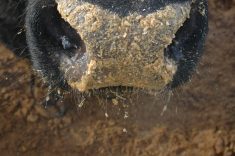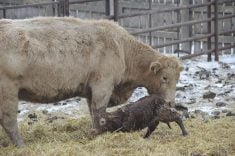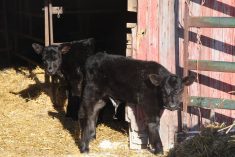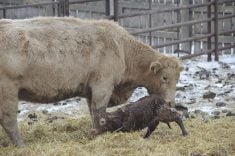Dr. Lisa Surber, a ruminant nutritionist and consultant in the Medicine Hat, Alta., region, has suggestions for people who are trying to raise an orphan calf.
Surber says calves need milk or milk replacer during their first 45 days of life, but generally start nibbling good forage if it is available. They usually consume a significant amount of forage at 45 to 90 days of age.
“When they are less than 90 days of age, the calves should still be receiving the majority of their nutrient intake from milk. After 90 days, calves will consume an increasing proportion of their nutrient intake from forage,” she says.
Read Also

The Western Producer Livestock Report – November 6, 2025
Western Producer Livestock Report for November 6, 2025. See U.S. & Canadian hog prices, Canadian bison & lamb market data and sales insights.
These calves can manage better on forage than a younger calf.
“Early weaned or orphaned calves can be raised to a normal weaning weight in a dry lot situation if given adequate high-quality feed. This gives the calf the greatest chance for success as opposed to leaving the orphaned calf with the herd,” says Surber.
Survival by stealing milk limits the calf’s growth, so access to creep feed will offer greater chance of success.
In some situations, ranchers might choose to keep a group of first-calf heifers separate from the rest of the herd, creep-feed their calves and put the orphans with them.
“Young calves need a ration that is highly palatable and highly nutritious. There are many options for feeds, but a commercial calf starter or COB (corn, oats and barley) with molasses can work nicely,” she says.
Commercial calf starter is ideal because it is fortified with vitamins and minerals and has the option for medication such as Rumensin, Bovatec or Deccox to prevent coccidiosis.
The orphan should first be given long-stemmed grass hay, which most calves will readily nibble on, especially if they’ve lived with their mother or a group of cows before. That can be top dressed with the grain-based ration for three to five days until the calf is eating well. This helps the calf start the transition from a forage-based ration to grain-based feed. Surber also recommends a mixed ration.
“Combining the grain-based commercial feed with chopped hay in a mixed ration prevents sorting and the calf filling up on the long-stemmed hay.”
When the calf is eating 1.5 percent of its body weight daily on this type of feed, it can be moved to a growing ration.
Surber also recommends vaccination for clostridial and respiratory diseases, since the calf has already been stressed by sudden weaning from its mother.















